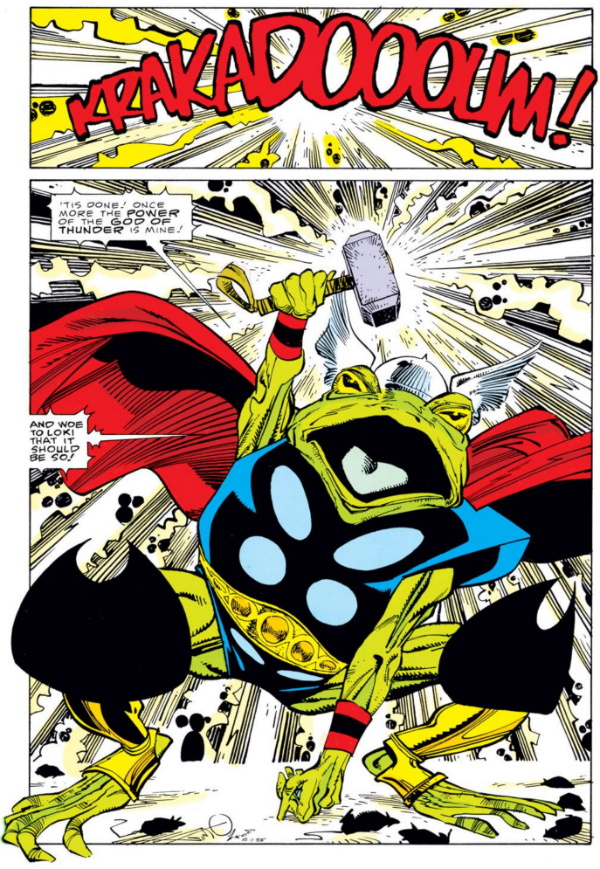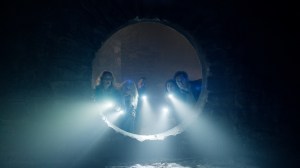
Last week, ComicBook.com debuted the first installment of its rundown of the 75 most iconic moments in Marvel Comics history. These are the moments that have defined the “House of Ideas” dating back to the publication of Marvel Comics #1 in October, 1939.
Videos by ComicBook.com
Moving right along, here’s moments #60-46:

60. Spider-Man Unmasks
From: Civil War #2 (August, 2006)
Mark Millar and Steve McNiven’s Civil War miniseries is jam-packed with shocking moments, but one of the biggest surprises came towards the end of the second issue when Spider-Man, a hero who had worked extraordinarily hard to keep his civilian identity as Peter Parker a secret, unmasks in front of a room of reporters in a show of support for the Superhuman Registration Act. With this move, Peter formally aligns himself with Tony Stark and the pro-Registration forces, a move he quickly regrets as Civil War marches on. Peter’s life is turned upside down by the unmasking. Just as he always feared, with his secret out, his family becomes a target for Marvel’s suprvillain population. And when Peter later switches sides and joins Captain America’s Secret Avengers, he becomes one of the most wanted vigilantes in all of the Marvel Universe. Spidey’s unmasking becomomes such a complicated predicament for the character, it is eventually retconned out of existence.

59. The Marriage of Peter Parker and Mary Jane Watson
From: Amazing Spider-man Annual #21 (June, 1987)
Speaking of retcons, in one of the most famous weddings in Marvel history, Peter Parker, aka Spider-Man, ties the knot with his long-term girlfriend Mary Jane Watson. The decision to marry Spider-Man off would be one of the most controversial storylines in the company’s history. Marvel’s then-editor-in-chief Jim Shooter reportedly wanted a big event to generate sales for Spidey and mandated the marriage, despite the fact that a number of creators were not in favor of the story. Critics of the Peter/MJ marriage said it would risk robbing Spider-Man of his youthfulness, while others thought the geeky character was in over his head marrying a supermodel like MJ. Regardless, the marriage stuck for 20 years until it was finally erased in the late 2000s as part of the even more controversial “One More Day” arc.

58. The Secret Identity of the Thunderbolts
From: Thunderbolts #1 (April, 1997)
In one of the most memorable twist endings in Marvel history, a brand new team of superheroes arrived on the scene in 1997 in the wake of the deaths of the Avengers and Fantastic Four (during the Onslaught event). After watching this new team, dubbed the Thunderbolts, take care of the Wrecking Crew, the leader of the team removes his mask and turns out to be longtime supervillain Baron Zemo. Zemo’s Thunderbolt teammates are unveiled as other members of the Masters of Evil. This revelation was such a well-received twist, the Kurt Busiek/Mark Bagley story was selected by fans to be a part of the Marvel 75th Anniversary Omnibus.

57. Captain America Learns the Identity of the Winter Soldier
From: Captain America vol. 5 #11 (November, 2005)
Ever sine Captain America was reintroduced in the Silver Age by Stan Lee and Jack Kirby, the death of Cap’s World War II partner Bucky Barnes was believed to be one of the most sacred and irreversible moments in Marvel history. That all changed in the mid-2000s when Ed Brubaker and Steve Epting resurrected Bucky as the brainwashed KGB operative, the “Winter Soldier.” Cap is initially in the dark about this mysterious and deadly assassin, but when a confidential envelope arrives at Cap’s apartment, he learns the shocking truth about his old buddy. The retcon of Bucky’s death proved to be so popular with critics and fans, the storyline became the focal point for this year’s Captain America: The Winter Soldier film.

56. Introducing Eternity
From: Strange Tales #138 (November, 1965)
The first wave of Doctor Strange stories by Stan Lee and Steve Ditko feature some of the most imaginative visuals from Marvel’s Silver Age. Ditko, who was considerably more famous for his stint on the Amazing Spider-Man, was essentially give carte blance by Marvel to do whatever he wanted in the lower profile Doctor Strange stories, and as a result, the cosmic entity known as Eternity was introduced. Eternity is significant in that he’s the first of Marvel’s numerous Cosmic Powers – which also include Death and Galactus – to be introduced. Providing a personality for a cosmic entity as abstract as Eternity was just another demonstration of how Marvel differed from the more traditional “Distinguished Competition” during the Silver Age.

55. Galactus Falls
From: Fantastic Four #243 (June, 1982)
In what was maybe the most celebrated run on Fantastic Four since the early days of Stan Lee and Jack Kirby, John Byrne provided scripts and pencils for many memorable stories in the 1980s, including one where the mighty planet eater Galactus was losing his strength and slowly dying. In what is easily the most stunning scene from Byrne’s tenure, various heroes come together to battle Galactus, only for the cosmic powerhouse to stumble and fall in defeat. From there, Reed Richards and other members of the Marvel U. must determine if Galactus should be put out of his misery and killed or be allowed to continue living. Reed’s decision to let Galactus live would comes back to haunt him as the storyline progresses.

54. Death of Karen Page
From: Daredevil vol. 2 #5 (March, 1999)
Hollywood filmmaker Kevin Smith’s time writing scripts for Daredevil in the late 1990s is frequently credited as being one of the key creative runs in Marvel Comics history. In what is arguably Smith’s defining moment as a comic book writer, Daredevil’s arch nemesis Bullseye murders Karen Page – Matt Murdock’s then-girlfriend and a key supporting character in the book for 35 years at that point. The fact that the deed is done by Bullseye – who murdered another one of Matt’s loves in Elektra during Frank Miller’s acclaimed run in the late 70s/early 80s – only further elevates the character as one of the deadliest sociopaths in the Marvel U.

53. Frog Thor
From: Thor #365 (March, 1986)
It’s a testament to Walt Simonson’s abilities as a comic book writer that he created a story where the iconic Thor was transformed into a frog, and it ended up being one of the greatest moments in comic book history. On paper, it sounds like a completely goofy idea that would only be good for a sight gag or two before the whole thing became embarrassing. Instead, Simonson produces a moment of great emotional heft – especially when the tiny frog struggles to grab his mighty hammer only to triumphantly hold it and transform into Frog Thor.

52. Doctor Doom Gains the Power Cosmic
From: Fantastic Four #57 (December, 1966)
Like peanut butter and chocolate, Stan Lee and Jack Kirby brought together two great things that worked great together in this landmark Fantastic Four issue. The evil Doctor Doom, arguably Lee and Kirby’s greatest villain, tricks the Silver Surfer and gains his vaunted power cosmic. From there, Doom proceeds to wreak an ultra-powered path of destruction in a bid to become Earth’s master. While Doom has had some amazing moments over the years, him obtaining the power of the Silver Surfer might be the best, especially if you’re one of those readers who cheers for the villains.

51. Spider-Man Meets the Kid Who Collects Spider-Man
From: Amazing Spider-Man #248 (January, 1984)
In what many fans consider to be one of the most heartbreaking Spider-Man stories of all time (which says a lot considering the amount of heartache the character has endured), Spidey meets Timothy Harrison, a young boy who declares himself Spidey’s biggest fan. At one point in the story, Tim asks to see who Spider-Man is under the mask, and Spidey, usually so protective of his identity (excluding moment No. 60), shockingly obliges. Spider-Man’s behavior is put into much better context when the story ends. Writer Roger Stern hits the audience with a huge emotional gut-punch and reveals that Tim has been diagnosed with leukemia and only has a few more weeks to live.

50. “Nice Piece of Work Kingpin, You Shouldn’t Have Signed It”
From: Daredevil #227 (February, 1986)
In the opening chapter of the celebrated “Born Again” story by Frank Miller and David Mazzucchelli, Matt Murdock’s life is systematically destroyed by Wilson “Kingpin” Fisk after the mob boss discovers Murdock’s secret identity as the hero Daredevil. The IRS freezes his assets, the banks foreclose on his apartment, and a cop testifies against Murdock claiming he paid a witness to perjure himself. Then, Murdock arrives at his former home and finds that it’s been destroyed. Among the wreckage is a piece of his Daredevil costume, tipping off to Murdock that the past six months of extreme misfortunate he was experience was all caused by the machinations of the Kingpin. Just an extraordinary capper to the first part of an epic story.

49. Introducing the Symbiote
From: Secret Wars #8 (December, 1984)
Spider-Man fans were shocked and outraged when their favorite web slinger showed up in a brand new black costume that he apparently picked up while battling an assembly of villains in the Secret Wars miniseries. In the eighth issue of Marvel’s first major event, we get to see how Spider-Man came across the duds. As it turns out, the costume is actually an living-breathing alien that forges a symbiotic bond with its “host.” Once the truth is discovered, Spidey quickly trashes the costume, but the symbiote would live on by bonding to Eddie Brock and becoming the supervillain Venom, as well as spawning additional monsters like Carnage. Years later, Venom and Carnage remain two of the most popular characters in Spidey’s rogues gallery, and they wouldn’t exist without this moment.

48. Beta Ray Bill Holds the Hammer
From: Thor #339 (January, 1984)
Readers knew they were in for something strange and special during Walt Simonson’s Thor creative run based solely on the cover of his very first issue. A strange, horse-faced creature is swinging the mighty Mjolnir through the book’s title – an appropriate image given just how much Simonson broke down Thor as we all knew it and redefined the character. Inside the comic, this creature, an alien named Beta Ray Bill, actually bests the Thunder God in combat and then grabs Mjolnir for himself, transforming himself into Thor. Two issues later, Odin would give Bill his own superpowered hammer, cementing the character as a key part of the Marvel Universe going forward.

47. Jackpot!
From: Amazing Spider-Man #42 (November, 1966)
Never has a character exuded such confidence and charisma as the red-headed beauty Mary Jane Watson in her first appearance in Amazing Spider-Man #42. Prior to MJ’s debut, Peter’s Aunt May had been trying to convince him to go out on a blind date with her friend, Anna Watson’s niece, Mary Jane. Peter avoids the topic altogether, but MJ still manages to endear herself to readers everywhere with the immortal words, “Face it tiger, you just hit the jackpot!” While Peter go on to have a serious romance with Gwen Stacy, after Gwen’s death, he started dating MJ. And after some fits and starts, the two would eventually get married.

46. Birth of Silver Surfer
From: Silver Surfer #1 (August, 1968)
While the enigmatic Silver Surfer had been surfing the Marvel cosmos for a few years after his debut in Fantastic Four #48, the character received a proper origin in the inaugural issue of his very own solo series. In this story, Norin Radd, aka the Surfer, talks about how he was transformed into the titular hero after he offered his services as a herald to Galactus in exchange for sparing his homeworld of Zenn-La. Meanwhile, via the image of the Surfer’s “birth,” John Buscema demonstrates from the very beginning of the series why he would go on to be the defining artist for the character.








